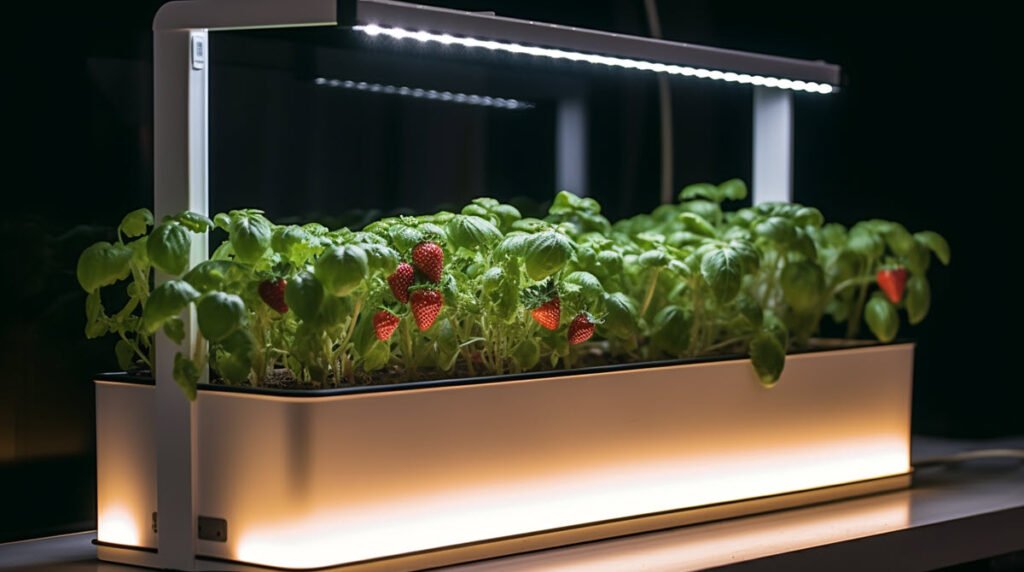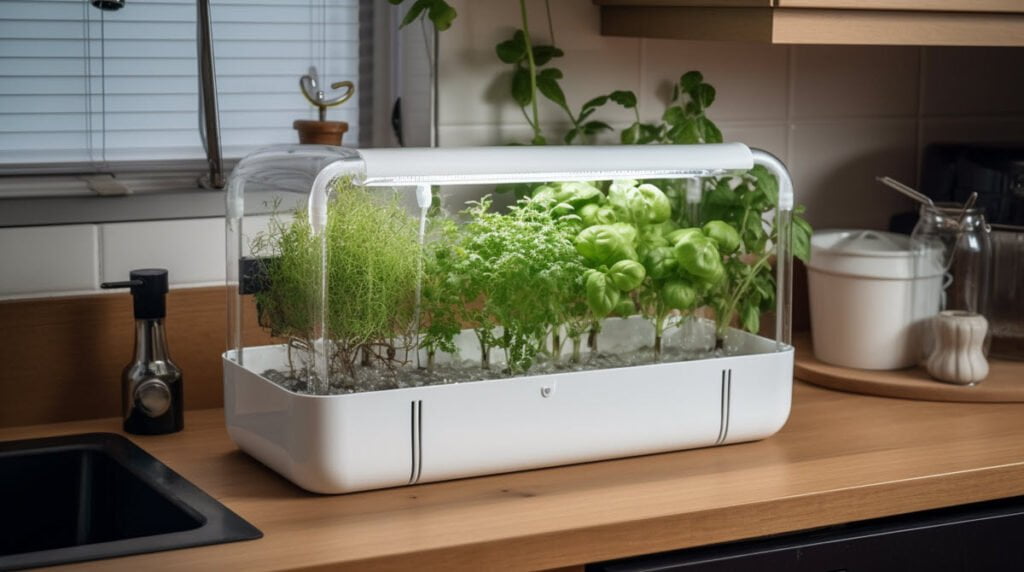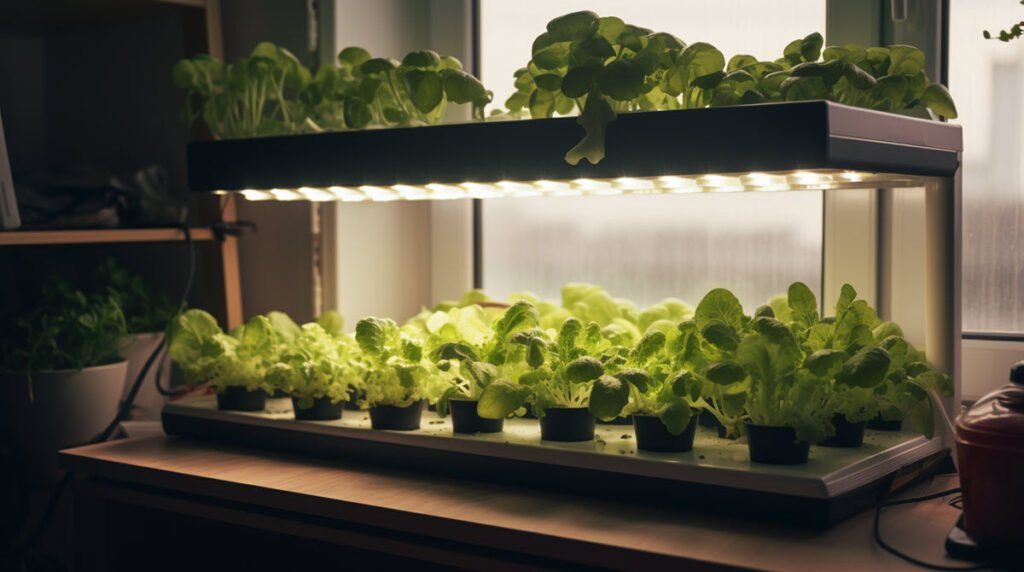Introduction
Growing strawberries indoors has become a popular trend among gardening enthusiasts. Hydroponics, in particular, has gained momentum as an efficient method of growing plants without the need for soil.
Hydroponics is a form of agriculture that focuses on cultivating plants in nutrient-rich water solutions rather than soil. With hydroponics, you can grow crops faster and more efficiently than traditional farming methods while using less water and fewer pesticides.
Definition of Hydroponics
Hydroponic systems are designed to allow plants to grow in a controlled environment where their growing conditions can be closely monitored and regulated. These systems typically involve suspending the plant’s roots in a nutrient-rich solution with artificial lighting serving as a substitute for natural sunlight.
In hydroponic systems, the nutrients needed for plant growth are dissolved in water instead of relying on soil to provide them. The roots absorb these nutrients directly from the water solution, which encourages faster growth and higher yields compared to traditional farming techniques.
Benefits of Growing Hydroponic Strawberries Indoor
One significant advantage of growing hydroponic strawberries indoors is that it allows you to control every aspect of your plant’s environment. You can adjust temperature, humidity levels, lighting conditions, and nutrient levels to create an optimal growing environment for your strawberry plants. Another benefit is that indoor hydroponic systems require less space since they do not rely on soil or external factors such as weather conditions.
This makes them ideal for those who want to grow fresh produce but do not have access to outdoor space or live in areas with harsh climates. Additionally, because hydroponic systems use less water than traditional farming methods due to their closed-loop system design, they are also environmentally friendly alternatives for gardening enthusiasts looking for sustainable farming practices.
Importance of Proper Planning and Preparation
Before diving into hydroponic strawberry cultivation, it is crucial to have a well-laid-out plan in place. Proper planning and preparation are essential for ensuring the success of your hydroponic system and your strawberry plants’ overall health.
Firstly, you need to determine which type of hydroponic growing system you want to use and the appropriate container for it. You should also consider the type of nutrient solution best suited for growing strawberries.
Proper lighting is also vital since indoor hydroponic systems rely on artificial light sources as a substitute for sunlight. Adequate lighting ensures that your plants receive enough light energy to support photosynthesis and fruit development.
Understanding the definition of hydroponics, the benefits of growing hydroponic strawberries indoors, and proper planning and preparation are all essential steps towards successful indoor strawberry cultivation. By following these steps, you can enjoy fresh strawberries year-round while minimizing environmental impact and maximizing yields.
Setting up a Hydroponic System for Strawberries
Choosing the Right Container and System Type
When it comes to setting up a hydroponic system for strawberries, choosing the right container and system type will be crucial. Selecting the wrong container or system type could lead to poor growth or even plant death. The most common types of hydroponic systems used for growing strawberries at home are drip irrigation systems, nutrient film technique (NFT) systems, and ebb and flow (flood and drain) systems.
Drip irrigation systems work by dripping nutrient solution onto the roots of the plants from above. NFT systems have a constant flow of nutrient solution running over the roots as they sit in small troughs.
Ebb and flow systems flood the plants with nutrient solution before draining it away again. The best system type for you will depend on your needs as well as available space.
Selecting the Appropriate Nutrient Solution
Choosing an appropriate nutrient solution is also critical for successful hydroponic strawberry cultivation. A balanced nutrient solution is necessary to ensure that your plants receive all of the necessary nutrients needed throughout their lifecycle.
Strawberries require high levels of nitrogen, phosphorus, potassium, calcium, magnesium, iron, manganese, copper, boron and zinc. These nutrients should be present in your chosen fertiliser mix at appropriate levels.
It’s important to note that not all fertilizers are created equal when it comes to hydroponic gardening; some options may contain chemical components that can harm your strawberry plants or even be harmful when consumed later down the line. Be sure to use only fertilisers that are specifically designed for hydroponics.
Lighting Requirements for Indoor Strawberry Cultivation
Lighting is another crucial factor when setting up a hydroponic system for growing strawberries indoors since there may not be enough natural light where you’ve chosen to set up your system. Strawberries require about 12-16 hours of light per day, which means you’ll need to provide adequate artificial lighting to ensure they receive the necessary amount. You can purchase specialised grow lights for strawberry plants that will provide the right spectrum and intensity of light needed, or you can use standard fluorescent or LED bulbs.
It’s important to position your lights in a way that ensures even distribution throughout the plant canopy, as well as proper distance from the plants. Ensure that your bulbs are not too close to the plants as they can burn them, and also make sure that they’re not too far away as this may reduce their effectiveness.
The Benefits of Choosing an Indoor Hydroponic System for Strawberries
Growing strawberries in an indoor hydroponic system offers several advantages over traditional outdoor soil cultivation. Firstly, hydroponic gardens allow for year-round production regardless of weather conditions, making it possible to have fresh strawberries all year round.
Secondly, hydroponic gardening eliminates the need for pesticides and other chemical herbicides since there are no weeds or pests present in a controlled environment. This means that your strawberries will be free from harmful residues which makes them healthier and safer for consumption.
Hydroponics uses significantly less water than traditional soil-based growing methods making it an environmentally-friendly alternative. This is because a hydroponic system recirculates water throughout its lifecycle thereby reducing water waste by up to 90%.
Growing Strawberry Plants in a Hydroponic System
Planting Strawberries in a Hydroponic System
Growing strawberries hydroponically can be an excellent option for those who want fresh fruits at home without having to deal with the challenges of traditional soil-based gardening. One of the first things to consider when planting strawberries in a hydroponic system is the type of container you will use. Containers with holes for net cups are ideal because they allow the plants’ roots to grow directly into the nutrient solution.
The strawberry plants should be placed in these net cups, and only the roots should be submerged in water. It’s essential to choose healthy strawberry seedlings that are free from any pests or diseases.
Once you have chosen your seedlings, it’s time to plant them. Ensure that each net cup has one plant and cover it with some growing medium like perlite or coconut coir.
Maintaining Optimal Growing Conditions: Temperature and Humidity
Maintaining optimal growing conditions is crucial for strawberry plants to thrive and produce fruits efficiently. A stable temperature range of 65°F-85°F is recommended for indoor hydroponic strawberry cultivation.
Temperatures outside this range can cause stress on your plants, leading to stunted growth, poor yields, or even death. Humidity is also a vital factor that affects hydroponic strawberry growth and yield quality.
The ideal humidity levels should remain within 40-60% throughout the day because low humidity can cause your plants’ leaves to dry out while high levels may attract pests and diseases. To maintain these conditions, using an air conditioner or heater might be necessary depending on your environmental conditions.
Monitoring and Adjusting Nutrient Levels
Unlike traditional soil-based gardening, hydroponics requires precise attention when it comes to nutrient levels in water solutions. Inadequate or excess nutrients can cause serious harm to your plants.
This is why you must monitor and adjust nutrient levels regularly. There are a few ways to monitor nutrient levels in a hydroponic system, including Electrical Conductivity (EC), pH level, and Total Dissolved Solids (TDS).
You can use an EC meter to measure the electrical conductivity of the solution, which indicates how much dissolved minerals are present in the water. The pH level should be kept between 5.5-6.5 in hydroponic strawberry cultivation, with TDS levels typically ranging from 800-1500 ppm.
If you notice that your plants’ leaves are turning yellow or brown, it may indicate that they are lacking certain nutrients. In this case, adjusting the nutrient solutions accordingly may help remedy the situation.
Growing strawberries hydroponically is an excellent way of having fresh fruits without worrying about soil-borne diseases and other challenges that come with traditional soil-based gardening practices. By following proper planting practices and maintaining optimal growing conditions such as temperature/humidity range and nutrient levels, you can have a successful harvest of healthy strawberries all year round!
Harvesting Strawberries from a Hydroponic System
Once your strawberries have reached maturity, it’s time to harvest them. But how do you know when they are ready? The first sign is usually a change in color from green to red.
However, this is not always the case as some varieties may remain partially green or white even when ripe. Another indication of readiness is the texture of the fruit; it should be firm but plump, with no soft spots or signs of mold.
To ensure that you harvest your strawberries at their peak flavor and nutrient content, it’s important to monitor your plants regularly during the growing season. Keep a record of when you planted each variety and check periodically for ripeness, using your senses of sight and touch to determine if they are ready for picking.
Identifying When Strawberries Are Ready to Harvest
One way to tell if strawberries are ripe is by tasting them. However, this isn’t always practical or desirable as you don’t want to waste any fruit.
Instead, look for the following signs:
- The fruit should be fully developed with no hint of green at the tips
- The color should be bright red for most varieties and pale yellow for some others
- The fruit should come off easily when lightly tugged but not fall off on its own
- The cap should still be attached and firmly embedded in the fruit
If you’re unsure about whether your strawberries are ready for harvesting, try picking one that looks ripe first before going ahead with the rest. This will give you an idea of what they should look like and taste like when fully matured.
Proper Techniques for Harvesting and Handling Strawberries
Once you’ve identified that your strawberries are ripe, it’s important to harvest them carefully and correctly to avoid damaging the plant or fruit. Here are some tips:
- Use clean, sharp scissors or pruning shears to cut the stems about half an inch above the fruit
- Avoid pulling or tugging on the fruit or stem, as this can damage both
- Harvest in the morning when temperatures are cooler and fruits are firmer
- Avoid harvesting when plants are wet as this can promote fungal growth
- Handle harvested fruit gently to prevent bruising or crushing; store them in single layers in shallow containers lined with paper towels to absorb excess moisture
With these tips, you should be able to harvest your hydroponic strawberries successfully. Remember that picking at peak ripeness will not only give you delicious flavor but also maximum nutritional value.
Conclusion
Summary of key points discussed in the article
In this article, we explored the benefits and techniques of growing hydroponic strawberries indoor. First, we defined hydroponics and described why it is a superior method for cultivating plants indoors. Then, we discussed how to set up a hydroponic system for strawberries including choosing the right container and system type, selecting appropriate nutrient solution, and lighting requirements.
We also looked at planting strawberries in a hydroponic system and maintaining optimal growing conditions such as temperature and humidity. We covered harvesting strawberries from a hydroponic system.
Through each section of this article, it was made clear that growing hydroponic strawberries indoor is an excellent method for producing fresh fruit in the comfort of your home. Hydroponics allows for greater control over growing conditions resulting in high-quality fruit yields throughout the year.
Future prospects on growing hydroponic strawberries at home
The future prospects for indoor hydroponics are incredibly promising with more growers entering the market every day. Indoor cultivation provides several advantages over traditional outdoor agriculture including greater control over environmental factors such as temperature and humidity. As technology continues to evolve, so too will our ability to grow plants indoors.
The development of cost-effective LED lighting systems has revolutionized indoor gardening by reducing energy costs while improving plant growth rates. In addition to technological advancements, research into plant nutrition is also ongoing with new formulations being developed that can increase yield while minimizing waste nutrients.
Final thoughts on the benefits of indoor hydroponics
Growing your own fresh produce has never been easier or more accessible than it is with indoor hydroponics. By removing reliance on soil-based agriculture methods you can grow high-quality fruits and vegetables all year round without worrying about weather changes or pest infestations. Not only is this beneficial to your health by providing you with fresh, nutrient-rich produce but it is also better for the environment by reducing waste and dependency on fossil fuels.
Overall, indoor hydroponic gardening is a smart choice for anyone who wants to eat healthier while also reducing their carbon footprint. With the ability to grow fruits and vegetables of all kinds from the comfort of your own home, there has never been a better time to get involved in this exciting industry.
References
- Krumins, J. (2016). The Complete Guide to Growing Your Own Fruits and Berries: Everything You Need to Know Explained Simply. Atlantic Publishing Company.
- Doan, T. T., & Nishihara, E. (2015). Effects of cultivar and nutrient solution on the growth and productivity of hydroponic-grown strawberries. Hortic. Environ. Biotechnol, 56(5), 693-700.
- Hochmuth, G., & Cantliffe, D. (2013). Hydroponic strawberry production in Florida. University of Florida, IFAS Extension. Retrieved from https://edis.ifas.ufl.edu/hs1250
- Nichols, M. A., & Langton, F. A. (2011). The hydroponic production of strawberries in New Zealand: A review. Acta Horticulturae, 926, 215-222.
- Paranjpe, A., & Cantliffe, D. (2017). Development of a hydroponic system for strawberry production in a controlled environment. HortScience, 52(9), S45-S46.



